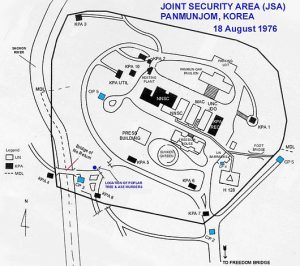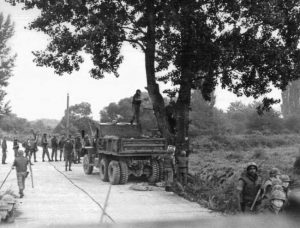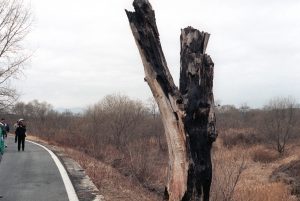 After the August 18, 1976 ace murder of two United States Army officers, Captain Arthur Bonifas and Lieutenant Mark Barrett, by North Korean soldiers, in the Joint Security Area located in the North Korean Demilitarized Zone, it was decided that something had to be done about a certain poplar tree that blocked the view of UN observers, allowing them to be assaulted and killed by the North Koreans, who claimed that the tree had been planted by Kim Il-Sung. It was dubbed the Panmunjom axe murder incident, and it was infuriating to the United States.
After the August 18, 1976 ace murder of two United States Army officers, Captain Arthur Bonifas and Lieutenant Mark Barrett, by North Korean soldiers, in the Joint Security Area located in the North Korean Demilitarized Zone, it was decided that something had to be done about a certain poplar tree that blocked the view of UN observers, allowing them to be assaulted and killed by the North Koreans, who claimed that the tree had been planted by Kim Il-Sung. It was dubbed the Panmunjom axe murder incident, and it was infuriating to the United States.
Three days later, American and South Korean forces launched Operation Paul Bunyan. There was one objective to Operation Paul Bunyan…cut down the tree with a show of force to intimidate North Korea into backing down. Operation Paul Bunyan was carried out on August 21 at 07:00, three days after the killings. A convoy of 23 American and South Korean vehicles, known as “Task Force Vierra”, named after Lieutenant Colonel Victor Vierra, commander of the United States Army Support Group, drove into the JSA without any warning to the North Koreans. There was just one observation post manned at that hour. The vehicles contained two eight-man teams of military engineers from the 2nd Engineer Battalion, 2nd Infantry Division, equipped with chain-saws to cut down the tree. Accompanying these teams were two 30-man security platoons from the Joint Security Force, who were armed with pistols and axe handles. The 1st Platoon secured the northern entrance to the JSA via the Bridge of No Return, while the 2nd Platoon secured the southern edge of the area. A team from B Company, commanded by Captain Walter Seifried, activated the detonation systems for the charges on Freedom Bridge and had the 165mm main gun of the M728 combat engineer vehicle aimed mid-span to ensure that the bridge would fall should the order be given for its destruction.
B Company, supporting E Company (bridge), were building M4T6 rafts on the Imjin River should the situation require emergency evacuation by that route. An additional 64-man task force of the South Korean Special Forces accompanied them, armed with clubs and trained in Tae Kwon Do, supposedly without firearms. Once  they parked their trucks near the Bridge of No Return, however, they started throwing out the sandbags that lined the truck bottoms, and handing out M16 rifles and M79 grenade launchers that had been concealed below. Several of the commandos also had M18 Claymore mines strapped to their chests with the firing mechanism in their hands, and were shouting at the North Koreans to cross the bridge. A U.S. Infantry company in 20 utility helicopters and seven Cobra attack helicopters circled behind them. Behind these helicopters, B-52 Stratofortresses, came from Guam escorted by US F-4 Phantom IIs from Kunsan Air Base and South Korean F-5 and F-86 fighters were visible flying across the sky at high altitude. At Taegu Air Base, F-111 bombers of the 366th Tactical Fighter Wing out of Mountain Home Air Force Base, were stationed, and F-4 Phantoms C and D from the 18th TFW Kadena Air Base and Clark Air Base were also deployed. The aircraft carrier USS Midway task force had also been moved to a station just offshore. Near the edges of the DMZ, many more heavily armed U.S. and South Korean infantry, artillery including the Second Battalion, 71st Air Defense Regiment armed with Improved Hawk missiles, and armor were waiting to back up the special operations team. Bases near the DMZ were prepared for demolition in case of a military response. The defense condition (DEFCON) was elevated on order of General Stilwell, as recounted in Colonel De LaTeur’s research paper later. 12,000 additional troops were ordered to Korea, including 1,800 Marines from Okinawa. During the operation, nuclear-capable strategic bombers circled over the JSA. According to an intelligence analyst monitoring the North Korea tactical radio net, the accumulation of force “blew their… minds.” Altogether, Task Force Vierra consisted of 813 men: almost all of the men of the United States Army Support Group, of which the Joint Security Force was a part; a South Korean reconnaissance company; a South Korean Special Forces company which had infiltrated the river area by the bridge the night before; and members of a reinforced composite rifle company from the 9th Infantry Regiment. In addition to this force, every UNC force in the rest of South Korea was on battle alert.
they parked their trucks near the Bridge of No Return, however, they started throwing out the sandbags that lined the truck bottoms, and handing out M16 rifles and M79 grenade launchers that had been concealed below. Several of the commandos also had M18 Claymore mines strapped to their chests with the firing mechanism in their hands, and were shouting at the North Koreans to cross the bridge. A U.S. Infantry company in 20 utility helicopters and seven Cobra attack helicopters circled behind them. Behind these helicopters, B-52 Stratofortresses, came from Guam escorted by US F-4 Phantom IIs from Kunsan Air Base and South Korean F-5 and F-86 fighters were visible flying across the sky at high altitude. At Taegu Air Base, F-111 bombers of the 366th Tactical Fighter Wing out of Mountain Home Air Force Base, were stationed, and F-4 Phantoms C and D from the 18th TFW Kadena Air Base and Clark Air Base were also deployed. The aircraft carrier USS Midway task force had also been moved to a station just offshore. Near the edges of the DMZ, many more heavily armed U.S. and South Korean infantry, artillery including the Second Battalion, 71st Air Defense Regiment armed with Improved Hawk missiles, and armor were waiting to back up the special operations team. Bases near the DMZ were prepared for demolition in case of a military response. The defense condition (DEFCON) was elevated on order of General Stilwell, as recounted in Colonel De LaTeur’s research paper later. 12,000 additional troops were ordered to Korea, including 1,800 Marines from Okinawa. During the operation, nuclear-capable strategic bombers circled over the JSA. According to an intelligence analyst monitoring the North Korea tactical radio net, the accumulation of force “blew their… minds.” Altogether, Task Force Vierra consisted of 813 men: almost all of the men of the United States Army Support Group, of which the Joint Security Force was a part; a South Korean reconnaissance company; a South Korean Special Forces company which had infiltrated the river area by the bridge the night before; and members of a reinforced composite rifle company from the 9th Infantry Regiment. In addition to this force, every UNC force in the rest of South Korea was on battle alert.

All this to cut down one tree!! My first thought on all this was…overkill, to the extreme!! That’s what I thought at first, but after researching the operation more, I realized that this was as much a show of force, as it was a way to cut down a tree that was really blocking a view that was necessary for keeping soldiers safe. North Korea needed to be shown what could come of such an attack, should it ever happen again. And it worked…North Korea accepted responsibility for the earlier killings. The incident is also known alternatively as the hatchet incident, the poplar tree incident, and the tree trimming incident. Final loss of life, two American Army officers, and one poplar tree.


One Response to Overkill, To The Extreme